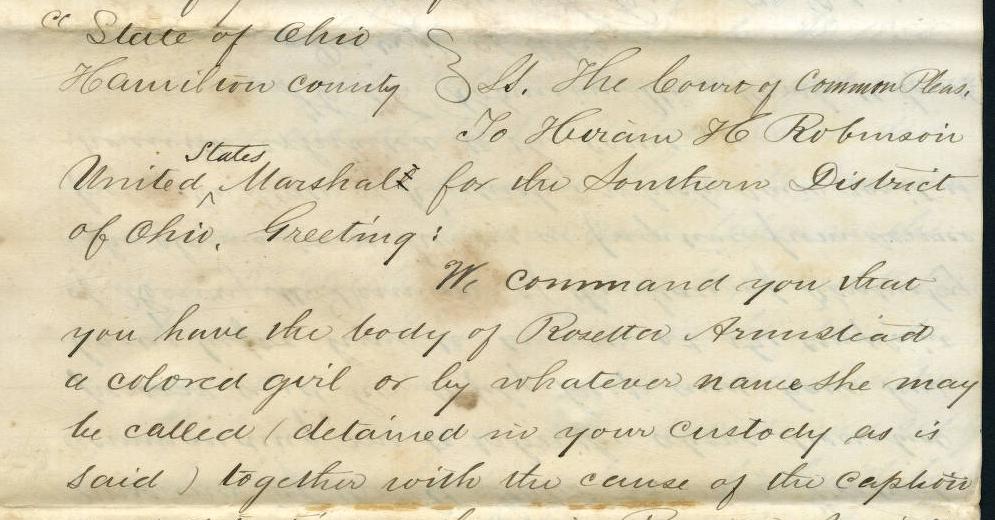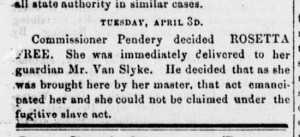The Rosetta Armstead Case: A Fight for Freedom

Ohio’s history with the anti-slavery movement is a long and storied one. Thanks to a group of documents newly added to Ohio Memory, we are able to share just one of those many remarkable stories with you today: the case of Rosetta Armstead.
In March of 1855, five years after the passage of the controversial Fugitive Slave Act of 1850, 16-year-old Rosetta was being transported from the home of her enslaver, Reverend Henry Dennison of Kentucky, under the control of Dennison’s agent, Jones Miller, to serve as a nursemaid for Dennison’s daughter in Virginia. Due to heavy ice in the Ohio River, Rosetta and Miller had to disembark from their steamboat at Cincinnati, and traveled by train through Columbus. When they learned the young woman was in Columbus, anti-slavery advocates in the city jumped into action, petitioning for a writ of habeas corpus in the Franklin County Probate Court. This obligated Miller to present Rosetta, whom the writ alleged was illegally in his custody, before a judge at the court in Columbus. The judge’s ruling freed Rosetta, as Ohio was a free state, and because she was a minor, appointed her to the guardianship of Lewis G. Van Slyke, who was active in Ohio’s abolition and anti-slavery movements.

Dennison traveled to Columbus to attempt to convince Rosetta to return as his property to Kentucky, but she refused, staunchly choosing her freedom and remaining in Ohio. Although Dennison at first appeared to accept her choice, he shortly thereafter reversed his course and filed a warrant for her arrest with a U.S. Marshal named Hiram Robinson under the Fugitive Slave law. Her allies filed an additional habeas corpus writ on her behalf, upon which the judge decided her detainment was unlawful and she would remain free.
Robinson was also jailed for contempt, for re-arresting Rosetta without cause following the previous ruling. The case was then brought to Cincinnati’s Southern District U.S. Circuit Court to be tried, and following an additional re-arrest of Rosetta, the release of Marshal Robinson, weeks of legal efforts, and a week of deliberation by Circuit Court Judge John Pendery, Rosetta was ultimately declared to have free status under both U.S. and Ohio law.
This case was seminal in many ways, and brought up critical questions to be answered in a sharply-divided country. Rosetta had been brought to free soil by an agent of her enslaver; could she then be called (and tried as) a “fugitive” from slavery? Did she earn her freedom as soon as she was brought to Ohio, or was freedom granted (manumitted) upon Dennison’s acceptance of her choice? What about her status as a minor? And what was the connection between a state writ of habeas corpus with regards to the imprisonment of a federal marshal?

The documents on Ohio Memory cover many of the details of this complex and important case, but you can read about it in greater detail in Reminiscences of Levi Coffin (1880) and the more recent Fugitive Slaves and the Underground Railroad in the Kentucky Borderland, by J. Blaine Hudson. The case was also reported in depth in the Ohio State Journal during 1855, as well as in numerous newspapers available through Chronicling America from the Library of Congress. We hope you’ll explore and consider this case — both in its impact on a nation struggling to find answers, and on a young woman who fought for her freedom, and won.
Thanks to Lily Birkhimer, Digital Projects Coordinator at the Ohio History Connection, for this week’s post!



Leave a Reply
You must be logged in to post a comment.